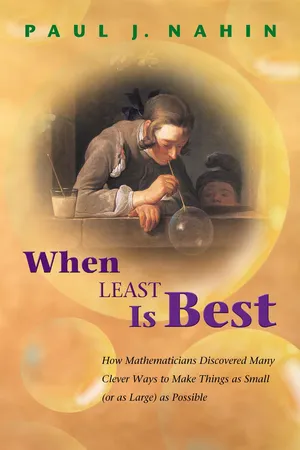
When Least Is Best
How Mathematicians Discovered Many Clever Ways to Make Things as Small (or as Large) as Possible
- 392 pages
- English
- ePUB (mobile friendly)
- Available on iOS & Android
When Least Is Best
How Mathematicians Discovered Many Clever Ways to Make Things as Small (or as Large) as Possible
About this book
What is the best way to photograph a speeding bullet? Why does light move through glass in the least amount of time possible? How can lost hikers find their way out of a forest? What will rainbows look like in the future? Why do soap bubbles have a shape that gives them the least area?
By combining the mathematical history of extrema with contemporary examples, Paul J. Nahin answers these intriguing questions and more in this engaging and witty volume. He shows how life often works at the extremes--with values becoming as small (or as large) as possible--and how mathematicians over the centuries have struggled to calculate these problems of minima and maxima. From medieval writings to the development of modern calculus to the current field of optimization, Nahin tells the story of Dido's problem, Fermat and Descartes, Torricelli, Bishop Berkeley, Goldschmidt, and more. Along the way, he explores how to build the shortest bridge possible between two towns, how to shop for garbage bags, how to vary speed during a race, and how to make the perfect basketball shot.
Written in a conversational tone and requiring only an early undergraduate level of mathematical knowledge, When Least Is Best is full of fascinating examples and ready-to-try-at-home experiments. This is the first book on optimization written for a wide audience, and math enthusiasts of all backgrounds will delight in its lively topics.
Frequently asked questions
- Essential is ideal for learners and professionals who enjoy exploring a wide range of subjects. Access the Essential Library with 800,000+ trusted titles and best-sellers across business, personal growth, and the humanities. Includes unlimited reading time and Standard Read Aloud voice.
- Complete: Perfect for advanced learners and researchers needing full, unrestricted access. Unlock 1.4M+ books across hundreds of subjects, including academic and specialized titles. The Complete Plan also includes advanced features like Premium Read Aloud and Research Assistant.
Please note we cannot support devices running on iOS 13 and Android 7 or earlier. Learn more about using the app.
Information
1.
Minimums, Maximums,
Derivatives, and
Computers
1.1 Introduction











Table of contents
- Cover
- Title
- Copyright
- Contents
- Preface to the Paperback Edition
- Preface
- 1. Minimums, Maximums, Derivatives, and Computers
- 2. The First Extremal Problems
- 3. Medieval Maximization and Some Modern Twists
- 4. The Forgotten War of Descartes and Fermat
- 5. Calculus Steps Forward, Center Stage
- 6. Beyond Calculus
- 7. The Modern Age Begins
- Appendix A. The AM-GM Inequality
- Appendix B. The AM-QM Inequality, and Jensen's Inequality
- Appendix C. “The Sagacity of the Bees”
- Appendix D. Every Convex Figure Has a Perimeter Bisector
- Appendix E. The Gravitational Free-Fall Descent Time along a Circle
- Appendix F. The Area Enclosed by a Closed Curve
- Appendix G. Beltrami's Identity
- Appendix H. The Last Word on the Lost Fisherman Problem
- Appendix I. Solution to the New Challenge Problem
- Acknowledgments
- Index